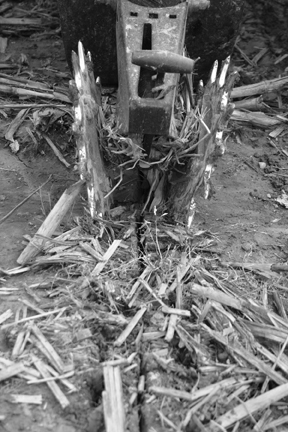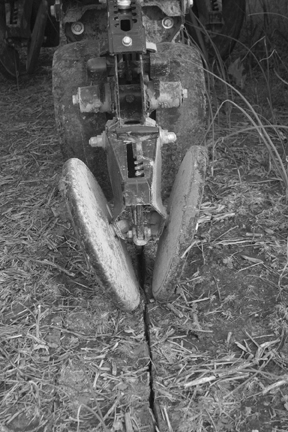Before you drop seed into the ground this spring, consider these planter set-up techniques to improve your planting performance.
(Editor's note: This article originally appeared in the April 2008 edition of No-Till Farmer.)
THE HEALTHY FUTURES prices for crop commodities probably has you chomping at the bit to get into the field and begin no-tilling your crops.
But before you pull that no-till corn planter into the field and set it into the ground, there’s work to do to make sure it will perform at the highest level possible.
When it comes to establishing a uniform stand that’s necessary for maximum yields, you can’t afford any miscues. Following are a few things to consider about setting up your corn planter before dropping that first kernel into the ground.
1) Level Your Planter. It’s always a good idea to take the no-till planter out into the field a few days prior to planting for a complete checkup. You need to spend enough time to make necessary adjustments, without being pressured to plant.
If the main frame is level from front to back and side to side, the parallel arms should run close to parallel with the ground. This adjustment will optimize the performance of the row cleaners, disc openers and especially the closing system.
Be aware that twin-line, split-row planter frames (such as Kinze Twin-Line planters) may need to be adjusted if the front units are full of seed, compared to when utilizing the rear units for corn only.
2) Remove Coulters. Most successful no-tillers have removed their coulters. This is a difficult step for some growers, but once they remove one coulter from a planter and see the results, they soon remove them all.
One of the problems that results from the use of no-till coulters is the throwing of soil out of the seed zone. This makes it difficult to gather soil back around the seed to achieve acceptable slot closure.
Soil throw is especially a problem with wavy coulters when planting in higher-moisture no-till soils at speeds above 5 mph.
Another problem with no-till coulters is that they commonly produce a false floor in the bottom of the seed slot, which can lead to poor seed-to-soil contact and reduced emergence.
|
|
This is common in dry areas and is compounded by the fact that some planter brands do not allow the no-till coulter to be raised up above the lower working depth of the double-disc openers.
The final problem with a no-till coulter occurs frequently within poorly drained soils and higher rainfall areas. Ponding of water often results within the depression created by the no-till coulter, and this commonly results in poor stands.
3) Floating Row Cleaners. Once the planter is properly leveled, the performance of row cleaners can be greatly improved. Floating row cleaners with depth bands are the design of choice for no-till conditions.
Ken Ferrie’s research in 2006 concluded that floating row cleaners offered a 10- to 13-bushel-per-acre yield advantage compared to fixed row cleaners.
Ferrie was quoted in Farm Journal saying, “In a heavy-residue environment, letting row cleaners with depth bands float makes a bigger difference in yield than I would have thought. It appears that Howard Martin, who introduced the depth bands years ago, was onto something important.”
Row cleaners clear residue and lightly till the seed zone to allow faster soil warming. Research has shown that removing residue from the soil surface and lightly tilling the seed zone can increase soil temperature by 6 to 8 degrees Fahrenheit compared to an area with undisturbed soil or residue.
This increased soil warming aids in faster emergence. The absence of residue reduces bouncing of the gauge wheels, especially critical in corn-after-corn rotations.
For producers who plan to no-till corn back into corn stalks, weights and/or down-pressure springs may need to be added to keep the floating row cleaner teeth engaged in residue and turning at a consistent speed.
Depth bands help control the amount of row cleaner tooth engagement and they also control the point at which residue exits the row cleaner wheel.
This is particularly important in heavy, loose residue conditions because the depth bands help prevent residue from bubbling up in the air and causing plugging.
4) Nutrient Placement. Placing pop-up fertilizer in the row with a product like the Keeton Seed Firmer, as well as additional nitrogen close to the seed row with a fertilizer opener, becomes important in no-till due to the fact soil temperatures are cooler in a no-till system. Most nutrients, especially phosphorus, are significantly less available at lower temperatures.
Keeton Seed Firmers help press seed into the bottom of the seed slot and can help position 3 to 5 gallons of pop-up fertilizer in the row. Soils low in phosphorus or pH are most responsive to this strategy, and yield responses are frequently seen when no-tilling early into cool soils.
|
|
When planting into cool soils or no-tilling corn after corn, the placement of 25 to 50 pounds of nitrogen per acre in a band 1 to 2 inches to the side of the row and slightly below the seed has provided many producers with significant yield gains.
Corn roots grow sideways and down at an angle of approximately 30 degrees, so accurate placement of fertilizer is essential. Unit-mounted fertilizer openers are preferred over frame-mounted openers because placement is much more consistent, especially on rolling ground or when making gradual turns.
Producers with frame-mounted fertilizer openers frequently compensate for this by adjusting them away from the seed zone; however, most of the benefits of the fertilizer placement are lost because the band of nutrients is too far away.
Some producers have also seen significant yield benefits by adding 10-34-0 to the nitrogen, which is placed alongside the row in a band.
Research by Mallarino et al (Agronomy Journal, 91.1:37) reinforces this and states, “the application of phosphorus fertilizer in a band with the planter increased early growth of no-till corn and phosphorus uptake compared to broadcast or deep-banded nutrient applications.”
5) Closing The Seed Slot. Some producers, especially those who plant in higher-moisture soils or soils with high clay content, struggle to achieve consistent closure of the seed slot. This leads to inconsistent emergence and high mortality losses to insects and birds.
A pair of 13-inch spiked closing wheels, used with a pair of reduced inner-diameter, gauge-wheel tires, helps elevate and close the seed slot, even in high-moisture environments. The teeth engage the soil and push the slot closed from both sides.
Depth bands may also be added to the closing system to provide depth control, but this is usually specific to producers who wish to use the same closing system on conventionally tilled soils.
Maximum performance with a spiked-wheel closing system is usually achieved with minimal down pressure on the closing wheel arm. Excessive down pressure lowers the rear of the closing wheel arm, which reduces the gathering action of the closing wheels and results in poor slot closure. This becomes much worse as the closing wheel teeth become worn.
Producers frequently add additional down pressure in an attempt to improve the closure of the seed slot, but this usually results in a lowering of the rear of the closing wheel arm and poorer seed slot closure.
Drag chains are a simple, low-cost attachment to level the seed zone, allowing more consistent soil drying and even crop emergence. The arms can be adjusted up and down to create the desired amount of soil dragging to fill in voids.

 WORN WHEELS. As the diameter of spiked closing wheels decline with use, they cause a lowering of the closing wheel arm. Once the closing wheel arm descends to the level shown, the gathering action changes to a parting action and poor closing results. Once 13-inch spiked closing wheels wear to less than 12 inches, they should be replaced.
WORN WHEELS. As the diameter of spiked closing wheels decline with use, they cause a lowering of the closing wheel arm. Once the closing wheel arm descends to the level shown, the gathering action changes to a parting action and poor closing results. Once 13-inch spiked closing wheels wear to less than 12 inches, they should be replaced. NEED FOR CLOSURE. Many no-tillers struggle when it comes to closing the seed slot. Conventional closing systems on planters work well in most conventional environments, but don’t close the slot in many higher-moisture no-till fields.
NEED FOR CLOSURE. Many no-tillers struggle when it comes to closing the seed slot. Conventional closing systems on planters work well in most conventional environments, but don’t close the slot in many higher-moisture no-till fields.





Post a comment
Report Abusive Comment